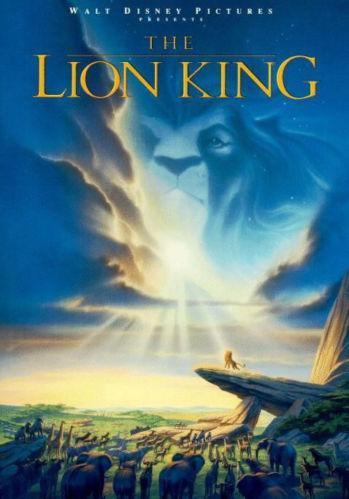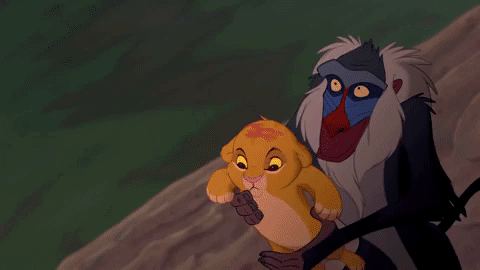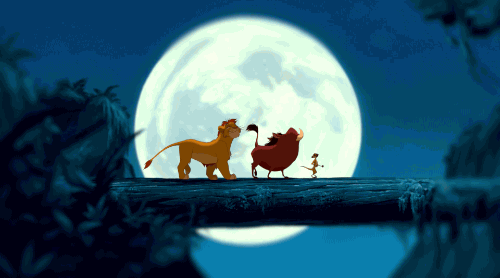The Lion King (1994): The Movie Structure Archives
- Genre: Disney/Coming of Age
- Writer: Irene Mecchi, Jonathan Roberts, and Linda Woolverton
- Director: Roger Allers and Rob Minkoff
Outline:
Contents
Act 1 (1%-25%)
- Hook: Simba, a young lion, is presented to the animals of the Pride Lands in a ceremony led by the shaman Rafiki, confirming his royalty and status as heir to the throne.
- Mufasa introduces Simba to his right to kingship when he is a bit older, but warns him that there are still places he cannot go.
- Inciting Event: Simba and his friend Nala elude their babysitter and sneak off to the Elephant graveyard thanks to encouragement from Scar. In the graveyard, Scar’s hyenas try to kill the cubs but Mufasa saves them.
- Key Event: Scar tricks Simba into entering a deep gorge where Scar leads a wildebeest stampede, trying to kill Simba. Scar alerts Mufasa to Simba being in danger and when Mufasa gets stuck on a ledge above the stampede Scar throws him into the herd. Mufasa is killed, but Simba survives.
- 1st Plot Point: Scar convinces Simba that he is responsible for his father’s death and drives him from the pride. Scar sends the hyenas to kill Simba, but they let him go at the last minute. Scar informs the pride of Simba and Mufasa’s deaths, leaving him as the sole heir to the throne.
Act 2 (25%-75%)
- Simba is found far from Pride Rock by Timon and Pumbaa, who raise Simba in their “Hakuna Matata” lifestyle in a distant oasis.
- 1st Pinch Point: Simba has grown into a young lion now and saves Timon and Pumbaa from a young lioness who turns out to be Nala. He and Nala explore their romance, but Nala refuses to stay in the oasis with him and demands he takes his rightful place as king of Pride Rock. She informs him of the destruction of his homeland by Scar, but Simba refuses to return home.
- Midpoint: Rafiki finds Simba and tries to soothe Simba’s guilt over his father’s death. Rafiki helps bring Simba to the ghost of his father who tells him, “Remember who you are,” pushing Simba to do as Nala says and retake the throne. Simba agrees to do so and sets out with Timon, Pumbaa, and Nala.
- 2nd Pinch Point: Upon arriving at Pride Rock, Simba and his friends find it in a desolate state, overtaken by famine. Simba also watches as Scar beats his mother.
- 3rd Plot Point: After announcing his return to the pride, Simba is publicly shamed by Scar, who forces him to admit to killing Mufasa.
Act 3 (75%-100%)
- Climax: Scar tries to kill Simba, but before doing so he whispers to him that he killed Mufasa, not Simba. Enraged, Simba turns the tables and raises the pride to battle with Scar and the hyenas.
- Climactic Moment: Simba corners Scar and gives him the chance to flee the Pride Lands, going into exile, and Scar tries to back down by blaming Mufasa’s death on the hyenas. Simba and Scar enter a duel and Simba wins when he pushes Scar over a cliff into a pit of the resentful hyenas, who turn on Scar.
- Resolution: Simba retakes the throne and the Pride Lands undergo a miraculous recovery, with the film closing on Rafiki presenting Simba and Nala’s cub to the animals of the Pride Lands, mirroring the opening scene.

Characters:
Character 1: Simba
- Simba’s arc is built on the influence of every other character in the story, and as a result his arc is the only major one in the film. He starts his arc an arrogant princeling, unwilling to listen and unwilling to mature. Until this point the world has been given to him without him needing to work for it. He doesn’t see how anyone could dislike him or take issue with him and looks forward to his rulership without understanding the responsibility that comes with that.
- Simba’s arrogance and naivety result in him trusting Scar and falling into his trap. After Mufasa’s death, Simba’s world view is shaken. He is no longer secure, no longer the heir to the throne. However, he is found by Timon and Pumbaa who continue raising him in a laid-back lifestyle. He refuses to deal with his guilt and doesn’t grow much as a result.

- Simba’s arrogance is challenged by both Nala and Rafiki, who try to force him to return to Pride Rock to take his rightful place as king. He resists taking responsibility, but a vision of Mufasa convinces him he has to act.
- Simba’s arc makes a sudden jump here as he goes from laid back child to king of Pride Rock. He overcomes his guilt not through self-forgiveness but by learning the truth from Scar at a pivotal moment and asserts his authority through physical might. The Resolution implies that he has grown into a just and responsible king, but the audience doesn’t see much of this process.
Theme: Earning the “Right to Rule”
The theme flirts with both “becoming a man” and “earning the ‘right to rule’,” but seems to learn most heavily on the latter. With Simba being the only character undergoing a major arc, the theme rides entirely on his development. Unfortunately, his arc is bumpy towards the end, and it doesn’t quite deliver this theme. Earning his “right to rule” comes most often from what other characters tell him to do, primarily from Nala and Rafiki. By taking responsibility for the effects of his disappearance and for Mufasa’s death he is able to overcome Scar and earn this right, but I can’t say it has the strongest thematic resonance.

As with the characters, the movie’s plot is rushed, but the theme jives well with the overall plot. The need for Simba to earn his rulership comes up repeatedly in musical numbers and dialog and defines his success at the Climax. Without taking responsibility for his past actions, he never would have healed Pride Rock and gained his place on the throne.
Symbolism is this movie’s strong suit, and helps fill the gaps where the characters or plot may seem rushed, providing for an engaging visual story that feels like it’s resonating well with itself. Simba’s roar, the ceremony for newborn royalty, Nala’s hunting skills, even the color palettes used in certain scenes (the dark blacks and greens in Scar’s scenes contrasted with the blues and oranges of Simba and Mufasa) repeat at key moments to remind the audience where they’ve been and how the story’s characters have grown. The symbolism here is fantastic, and it makes up for a lot of other flaws in the story’s overall development.
Pacing:
Pacing is not The Lion King’s strong suit, as you can see when looking at the outline above. There is little breathing room during any Act, making the fast pace of the Third Act seem par for the course. The movie has to create its tension in other ways since it struggles to do so with its pacing. A lot of that is due to the lengthy (and very enjoyable!) musical numbers. While these are great and visually engaging, from a story perspective they didn’t master moving the plot along the way later Disney films would.
Conclusion:
The Lion King is a great movie (and one of my personal favorites) and no one can deny it captured its audiences well. It goes to show that, especially for movies, sometimes other factors contribute to an enjoyable story beyond sound structure and pacing. The visual and musical enjoyment of the movie made a big impact, making up for a lot of flawed story design and a main character who is underdeveloped.


Leave a Reply